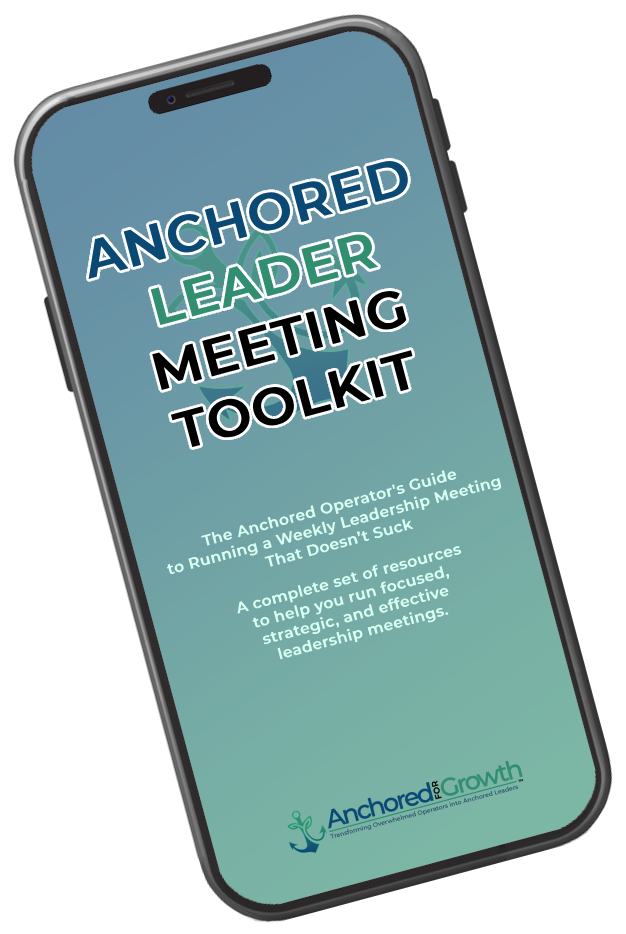Your team’s most valuable resource is their focused time. Stop wasting it in meetings that feel like a chaotic waste of everyone’s energy.
It’s 11 AM on Tuesday, and you’re already in your third meeting of the day. There’s no clear agenda, the conversation is drifting, and you can feel the collective energy draining from the room. Sound familiar? It’s all to common.
You’re not imagining it. A 2022, post-covid, study by Microsoft found that the average number of meetings per week had increased by 153%, and it doesn’t seem to have decreased very much. For senior leadership team, the most expensive group of people in your company, this isn’t just an annoyance; it’s a massive drain on strategic resources that can slow growth in more ways than one.
Consider this your guide to reclaiming that time. We’ll walk through a framework for running a weekly leadership meeting – not an all-hands stand-up, but the senior team sync – that is focused, strategic, and actually moves the business forward.
The Two Fatal Flaws of Ineffective Leadership Meetings
Almost every ineffective leadership meeting is a result of two simple failures: no clear purpose and no respect for time.
Flaw #1: The Missing Agenda
Without a clear leadership meeting agenda, the meeting defaults to the loudest voice or the most recent crisis, not the most important strategic topic. It becomes a reactive session, not a proactive one.
Flaw #2: The Time Black Hole
Meetings without a hard stop time create anxiety and encourage rambling. They train your team that their time is not a valuable, protected resource.
The Anchored Framework for Your Weekly Leadership Meeting Agenda
A great leadership meeting needs a rhythm and a structure. It should be a predictable cadence that your team can rely on.
The Cadence: Finding Your Rhythm
My coaching clients have shared that a 60-90 minute deep dive every single week can be too much. Instead, consider a rhythm that provides both depth and consistency:
- Weeks 1 & 3 (The Deep Dive – 90 minutes): A full strategic meeting following the agenda below.
- Weeks 2 & 4 (The Check-In – 30 minutes): A shorter meeting focused exclusively on KPI review and progress on action items from the previous deep dive, with the key players.
The 8 Parts to a Great Leadership Meeting Agenda: The 90-Minute Deep Dive Flow
This is your blueprint for a 90-minute strategic session that moves the business forward. Think of it less as a rigid script and more as a structured container for the most important conversations.
- The Welcome & Level-Set (5 mins): The meeting lead (often the COO) kicks things off, stating the single most important objective for the session and confirming the agenda. This ensures everyone is present and focused on the same goal from the very first minute.
- Wins & Lessons Learned (10 mins): Each leader shares one significant success or valuable lesson from the past week. This starts the meeting with positive momentum and fosters a culture of shared learning.
- KPI & Scorecard Review (15 mins): A quick, data-driven check-in on the company’s vital signs. The goal here isn’t to solve problems but to spot trends and identify any red flags that need to be addressed later in the meeting.
- Strategic Priorities (15 mins): This is where you zoom out. Discuss the progress, roadblocks, and next steps for the company’s 1-3 most important quarterly goals or “Rocks.” This keeps the team focused on the big picture, not just the daily fires.
- The Core Challenge (20 mins): This is the heart of the meeting. Tackle the single, pre-determined issue that requires a collective decision. This dedicated time allows for healthy debate and ensures you leave with a clear resolution.
- The Open Forum (10 mins): A time-boxed space for any critical, last-minute topics or to give the CEO a dedicated slot to share their thoughts, preventing tangents throughout the rest of the meeting.
Pro Tip: Create a “Idea Dock” section directly in your shared agenda document. When a great but off-topic idea comes up during the meeting, you can say, “That’s a fantastic idea. I’m adding it to our Idea Dock to make sure we don’t lose it, and we’ll address it later.” This validates the idea without derailing the meeting.
- The Action Plan (10 mins): Before anyone leaves, verbally recap every decision made, assign a single owner to each action item, and set a clear delivery date. This is the key to turning conversation into tangible progress.
- Drop The Anchor (5 mins): Conclude by agreeing on the key messages that need to be shared with the rest of the team, ensuring alignment flows down through the entire organization.
Consider This Post: Untangling the Spaghetti: A Guide to Business Process Simplification – A great meeting is a system. If you’re ready to apply this thinking to other parts of your business, this guide provides a 5-step framework for simplifying your core processes.

Ready to Design Your Perfect Meeting?
Reading about a better meeting is one thing. Having the tools to run one is another.
To help you put these principles into immediate action, I’ve created The Anchored Leadership Meeting Toolkit. It’s a free, comprehensive package of all the resources you need to run your most effective and efficient leadership sync ever.
Inside, you’ll get:
- A printable 90-minute Deep Dive Agenda Template.
- A simple Pre-Meeting Facilitator’s Checklist.
- A ready-to-use Post-Meeting Action Item Tracker.
- A “Rules of Engagement” one-pager to align your team.
Your Role as the COO: The Master of the Meeting
Having a great agenda is half the battle; the other half is skilled facilitation. As the COO or operational leader, this is your domain. Your role is to be the keeper of the agenda and the master of the time.
Before the Meeting: The Pre-Sync
If you do nothing else, align with your CEO before the meeting. Understand their priorities and any potential tangents. This 5-minute pre-sync can save you 30 minutes of chaos in the meeting itself.
Consider This Post: If you are having difficulties with the relationship you have with your CEO, The Visionary and Integrator: 3 Conversations to Define Your Partnership, might be a great place to start.
During the Leadership Meeting: The Facilitator
Your job is to protect the structure. Keep a visible timer and politely park off-topic conversations by saying, “That’s a great point for a separate discussion. Let’s add it to our ‘parking lot’ and stick to our current topic to respect everyone’s time.”
For virtual meetings, enforce a simple but powerful rule: cameras on. This ensures everyone is present and engaged. If someone feels tempted to multitask, it’s a signal that they may not be needed for that portion of the conversation.
Pro Tip: Start and end your meeting on time, every single time, even if people are late. This is the single most powerful way to train your team that you respect their time. The first few times, it might feel awkward, but it quickly establishes a culture of punctuality and efficiency.
A Note on Attendance: Use Strategic “Off-Ramps”
A leadership meeting doesn’t mean every leader needs to be present for every minute. Structure your agenda to tackle cross-functional topics first. This creates natural “off-ramps” for attendees to exit gracefully when their input is no longer required. For example: the CFO might be crucial for the KPI review and strategic priorities but can leave before a deep dive into a marketing-specific challenge.
The ADHD-Friendly Upgrade: A Guide for Neurodivergent Leaders
A 90-minute meeting can feel like an eternity for an ADHD-wired brain. These strategies aren’t just about coping; they’re about creating an environment where you can perform at your best.
Before the Meeting
- Circulate a Timed Agenda: A clear, time-bound agenda is a lifeline. It provides the structure your brain needs to stay on track and helps manage the anxiety of an open-ended conversation.
- Distribute Key Documents in Advance: Sending out any reports or memos 24 hours ahead of time allows you to process the information on your own time, reducing the cognitive load of trying to read and listen simultaneously.
During the Meeting
- Externalize Your Thoughts: Don’t rely on your working memory. Take notes—either on paper or digitally—to stay engaged and capture key ideas that you can refer back to.
- Keep it Visual: A shared screen showing the agenda, a dashboard with the KPIs, or a virtual whiteboard for brainstorming helps anchor your attention and makes the conversation easier to follow.
- Embrace Subtle Movement: If you feel your focus drifting, use small physical movements to stay grounded. Squeeze your calves, quietly tap your fingers on your leg, or shift your posture.
- Use an External Timer: A visible timer, especially a countdown timer, for each agenda item creates a sense of pace and healthy urgency, which can help a dopamine-seeking brain stay locked in.
Pro Tip: For virtual meetings, use a tool that can automatically transcribe and summarize the conversation. This acts as a powerful backup for your working memory and allows you to stay fully present in the discussion instead of worrying about capturing every single word.
After the Meeting
- Do a 2-Minute Recap: Immediately after the meeting, sync up with a colleague or the meeting lead for a quick verbal review of your personal action items and deadlines. This is a crucial step to solidify your understanding.
- Organize Your Notes Immediately: Before you move on to your next task, take five minutes to organize your notes. Transfer any action items to your task manager and file your notes where you can easily find them later.
ADHD-Friendly Tips for Staying Engaged in Leadership Meetings
For an ADHD-wired leader, that sitting still and staying engaged can be difficult. Here are a few ways to stay focused.
- For the Inattentive Type: Sit up front, if possible. That peer pressure can keep you engaged for longer than you would be otherwise. In a virtual meeting, have the video call be the only window open on your screen.
- For the Hyperactive Type: Use subtle movements to discharge energy. Flick your fingers under the table or squeeze your calves. These small movements can help you stay regulated without being distracting.
Conclusion: Stop Enduring Meetings, Start Designing Them
It’s easy to become cynical about meetings. But a well-run weekly leadership meeting is one of the highest-leverage tools a COO has to build a calm, focused, and aligned organization.
The shift happens when you stop seeing meetings as a passive obligation and start seeing them as an active design project. By establishing a clear and consistent leadership meeting agenda, you create a predictable rhythm of clarity and focus that cascades throughout the entire company.
Stop dreading your meetings. Start designing them to be the anchor of your week and the engine of your company’s momentum.
Ready to Build Your Full Operating System?
Running a great weekly leadership meeting is a powerful first step toward creating clarity and focus. But it’s often just one piece of a much larger puzzle.
If you’re ready to go beyond fixing the symptoms and start building a complete, resilient operating system for your leadership and your company, a complimentary Clarity Call is your best next step. In this session, we’ll diagnose your biggest operational challenges and map out a clear plan to help you become the strategic, anchored leader your business needs.







